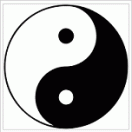Yin Yang Principle and Chess(continuation of Optimal Design ..)

Yin-Yang, Central Symmetric Monad*
All well know this famous monad. The basic idea behind the Daoist concept of "Yin and Yang" is to divide the things of nature into two fundamental categories: Yin and Yang. These are complementary opposites, such as male(yang) and female(yin), water and fire, black and white, strong and weak and so on. My purpose here is not to construct an elaborate philosophical conceit using Chess and the Monada division, but simply to express in a memorable way a view one might want to adopt while playing and designing a Chess game.
In any business before designing something, we should see before ourselves the purpose that we achieve. Chess by nature is a symmetric game and all Chess parameters should be symmetric.
For example: 1.White squares = Black squares; 2.Identical pieces from both sites; 3.Identical setup (central symmetry not "mirror image"); 4.Symmetrical pawns protection; 5.Total protection of all pieces in initial position; 6.Free squares (in the beginning of the game) = Squares with pieces (Pieces density =50%); 7.Identical Chess rules for both sides; 8.Shape of the board - square (not rectangular); 8.Quantity of Pawns = Quantity of Pieces; 9.Complete all moves light peaces. 10.Quantity Simple moves Pieces = Quantity Complex moves Pieces and so on. All these are well-known things. These conditions are obligatory only if we aspire to design absolutely symmetric game. Well-known game Go is completely based on the above-stated concept and 4 thousand years are justified with purpose.
Chess is a good balanced game. Any infringement of this balance breaks all symmetry of the game and it becomes unbalanced.
Consider the following situations:
Thickness of a Position Vs Advantage of opponent`s Territory. This is a frequent dilemma: do you choose the move that provides thickness or the one that claims or solidifies territory?
Extra Pieces Vs Initiative?
Attack Vs Defense?
Many Bad pieces Vs few Good Pieces?
Development Vs Material advantage?
Strong Piece (e.g. Queen) Vs a Tricky Piece (e.g. Knight)?
Quantity Vs Quality? (for exp. Quality, accrueing up to a maximum, gives rise to quantity. The quantity gives rise to quality. This is especially visible in the example of the Queen's gambit in Chess. The Queen, most valuable piece on a chessboard, is endowed. Owing to it item advantage which conducts to a victory is reached. Quality turns to quantity. The situation becomes equivalent to quantitative overweight of pieces (for short time).
King Safety move Vs an Attack move?
Tempo Vs Slow Development?
One passed Pawn Vs many blocked Pawns and so on.
What is good? I don`t know. I think nobody knows.
But, Ying Yang Principle can help. Unreasonable players try to take both, but stronger ones recognise that some kind of exchange is required. Granting the opponent territory while taking thickness(or extra pieces) is not worth it if that thickness cannot be used, taking profit is a bad deal if the price is giving the opponent something can be used. Any Chess combination it is: a sacrifice and forced sequence of moves to gain a certain advantage. But any way you have to give but after this to take advantage. This is a pure Yin-Yang Principle.
To gain space, you usually have to sacrifice time. To gain something, you should be loss something in any way. Of course, when we are design Chess game all this questions will be important for us.
I think ideal Chess game must be like this famous monad. And all principles this monada must be applied to a Chess game. For this reason it is desirable to follow a principle of a monad and all parameters new Chess variant should be balanced and symmetric. And at last, play flexibly because "flexibly" is right word for Ying-Yang principle.
Any way, it may not be best way for designing. But, I think it may be a little help in designing a good Chess variant.
Notes
APPENDIX * - Either side of the two opposites always restricts and acts on the other. This process of mutual restriction and interaction is the operation of yin and yang, without which change would not occur. Thus the two opposites of yin and yang do not exist as an entity in a still and unconcerned state. They constantly interact with each other, hence the alteration and development of an object. Each of the two aspects is the condition for the other's existence and neither can exist in isolation. For example, daytime is yang, night in yin, without day there would be no night; upper is yang, lower is yin; left is yang, right is yin, etc., each pair exists in a state of mutual dependence, and without its opposite it could not exist. In certain circumstances and at a certain stage of development, each of the two aspects of yin and yang, within an object, will transform from yin into yang and from yang into yin. The mutual consuming-increasing of yin and yang is a process of quantitative change, and the mutual transformation of yin and yang is a process of qualitative change.
The above-mentioned relationships of mutual opposing, depending, consuming-increasing, and transforming of yin and yang are the basic content of Yin-Yang theory. This 'user submitted' page is a collaboration between the posting user and the Chess Variant Pages. Registered contributors to the Chess Variant Pages have the ability to post their own works, subject to review and editing by the Chess Variant Pages Editorial Staff.
This 'user submitted' page is a collaboration between the posting user and the Chess Variant Pages. Registered contributors to the Chess Variant Pages have the ability to post their own works, subject to review and editing by the Chess Variant Pages Editorial Staff.
By Namik Zade.
Web page created: 2006-06-10. Web page last updated: 2006-06-10